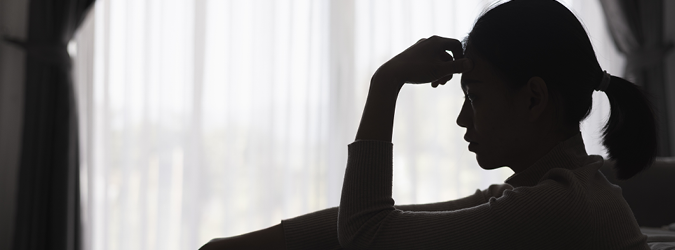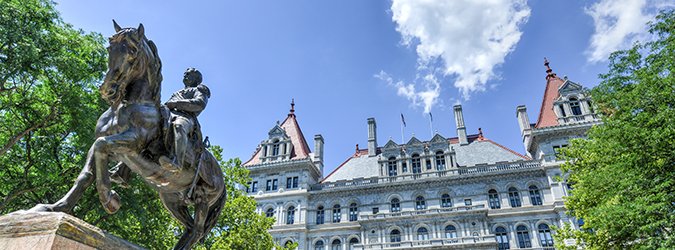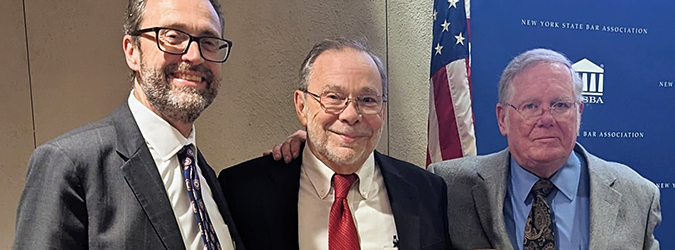Trauma, Mental Health and the Lawyer
12.14.2022
So, Netflix has this intriguing series called “The Sinner,” starring Bill Pullman as an empathetic police detective who is characterized by his ability to see beyond the conventional facts of a crime presented in the opening episode of each season. In Season One, Cora Tennetti (Jessica Biel) is a typical upstate New York mother and wife who is out for a day at the beach with her family. Suddenly, when some young people in front of them begin horsing around on their towels, a song on their radio triggers her into a violent episode where she stabs one of the men to death.
At first blush, there are no facts in dispute. There is a clear case of murder. And Cora denies none of it. What is inexplicable is her motive to commit the act and whether she was aware of her actions. The entire first season centers around the interplay between childhood trauma, complex PTSD and repressed memories, as set against our criminal justice understanding of immorality and right and wrong.
Our criminal defense bar friends will immediately pick up errors in the process and the application of the standards of review, illegal police interview practices, as well as suggestive psychotherapeutic techniques that would not be considered ethical or admissible.[1] “Despite the many misconceptions of forensic psychiatry and the law . . . [the show] does adequately reveal the negative impact of trauma, and it challenges viewers’ thinking about how this should affect the disposition of criminal cases. It also allows for a different definition of a ‘sinner.’”[2]
So why would challenging our views of what makes a “sinner” matter so much for lawyers, particularly in today’s charged and polarized environment? Because the show wants to reveal to us (albeit creatively from a criminal procedure standpoint) that the entrenched and inhumane parts of our legal systems repeatedly fail to consider (or outright deny the relevance of) the impact of trauma (individual, community, intergenerational, marginalized peoples, etc). It also shades in the gray of the continuum that is “mental illness” or “mental health” rather than using those terms in the binary manner so common today. And lawyers should take note because the very training to “think like a lawyer” leads directly to a “no gray zone” – a kind of dehumanized “black and white,” all-or-nothing thinking that can cause us to overlook the very human factors that are at the heart of a system – including ourselves.
Trauma and Mental Illness in the Legal System
There is no question that anyone who traverses the legal system – particularly the criminal justice system or our family courts – is at risk for exposure to trauma. Natalie Netzel, proposed in the June 2022 edition of Minnesota State Bar Association’s “Bench + Bar” that:
On its most basic level, trauma occurs when an event happens to an individual, or group, over which they have no control, with little power to change their circumstances, and which overwhelms their ability to cope. When the events happen without the buffer of supportive connections, or the availability of healing practices, brain chemistry changes in fundamental ways . . . for many of our clients, their interaction with the legal system represents an event that overwhelms their ability to cope and over which they have little if any control, and that is traumatic in and of itself.[3]
It is also beyond doubt that extensive trauma histories are present in many of the cases handled daily by lawyers across New York. The research into Adverse Childhood Experiences (ACES) “showed a connection between experiencing specific adverse events in childhood and resulting adverse health and social outcomes.”[4] Netzel writes that experiencing the processes of family separation through removal, custody, and immigration policies can diminish communities, resulting adverse community experiences – making certain communities less resilient than others.[5] When clinicians refer to the coupling of individual trauma and community trauma, they call it a “pair of aces,” thereby acknowledging that experiencing trauma can be far more than an individual event and that it increases rates of mental illness and addiction throughout a lifetime.[6]
This also true for the lawyers who practice in the system and “often encounter traumatic responses as if they themselves were experiencing the trauma.”[7] Vicarious trauma or secondary trauma is breathtakingly common in the legal profession and yet very little information or preventative techniques are provided to its practitioners. Dr. Kerry O’Hara, specializing in “group think” in legal culture and lawyer psychology, has lectured widely to legal audiences about the dangers of vicarious trauma, sharing that witnessing the suffering of others can lead to existential struggles and changes in our world view.[8] Dr. O’Hara says, “The answer is not to create emotional barriers but to accept that our work changes us.”[9]
But how many of us were told that our work would fundamentally change us? How many of us were given the education necessary to be on the lookout for such changes and the tools for how to mitigate them? Or even get help outside of ourselves if and when the time came? Unfortunately, the answer is not many. We are responsible as a profession for the chronic failure to adequately prepare law students and lawyers for the occupational hazards endemic in lawyering.[10] Even worse, we wholesale fail to provide the mitigating skills and tools that repeatedly prove to be life-saving in offsetting the impacts to the psyche of lawyering.
A Professional Shift From Self-Care to ‘Mutual’ Care
Lawyers find themselves in a “hand and glove” relationship with the impacts of the broader systems that implicate suffering and can impede treatment and recovery. That which impacts our clients impacts lawyers, as the research has demonstrated. Acknowledging this relationship is the first step in being able to shift resources, training, education, funding and policy to a more humanized view of the legal system and lawyering.[11] “Merely preaching self-care, in a profession that makes little space for it, makes it a kind of unfunded mandate – one more way lawyers fall short. One more way to fail.”[12]
In her call for a more holistic, communal view of healing, Netzel proposes that
models of communal or mutual care, rather than self-care, are essential in creating institutions and systems that truly understand and work to address trauma. The legal profession needs to adopt an approach to healing that recognizes mutual care . . . [W]e need to work together to create a profession that allows and respects the time and space needed to take care of oneself. We need to celebrate healthy boundaries and stop the glorification of toughing it out.[13]
The New York State Bar Association’s Task Force on Attorney Well-Being recognized the need to begin to move from the focus on the individual lawyer’s struggle to a broader, more holistic approach. In its October 2021 report, the task force noted:
While the well-being of lawyers may seem like an individual lawyer’s problem, the data has been sounding an alarm for the better part of three decades that the training, culture, and economics of law contribute exponentially to the suffering in our profession. To truly address the systemic issues in law, we must look to the precedent of the profession as a command to take up a collective responsibility – to each other. We must move from striving alone to thriving together if we are to survive the present challenges.[14]
Lawyers deserve the tools and techniques that enable them to stay compassionately present to the suffering of others, while practicing skillful protection. We do not have to armor ourselves like gladiators to be safe in a profession that has inherent risks.[15] To that end, the New York State Bar Association’s newly formed Committee on Attorney Well-Being has begun to cultivate new training programs for NYSBA members that focus on issue-awareness and professional skill development – targeting the existential struggles, traumas and isolation that lead to suffering in our profession. We can and should broaden our view of what it means to be “well-trained” as a lawyer – to be in service to our clients and, also, to ourselves.
Libby Coreno is current co-chair of the NYSBA Committee on Attorney Well-Being and served as the co-chair of NYSBA’s Task Force on Attorney Well-Being from 2020–2021. Along with Dr. Kerry Murray O’Hara, PsyD, Coreno hosted the first-ever five-part Attorney Well-Being Podcast for NYSBA. In 2022, Coreno and O’Hara launched the Humanized Lawyer Project, a revolutionary five-week program focused on individual and group skill development to target the “emotional amputation” at the root of legal training and practice.
[1] Chandler Hicks et al, Trauma Versus Immorality: A Review of ‘The Sinner,’ Journal of the American Academy of Psychiatry and the Law, September 2020, 48 (3) 418-419, https://doi.org/10.29158/JAPL200057-20.
[2] Id.
[3] Natalie Netzel, Hiding in Plain Sight, Bench + Bar, Minnesota State Bar Association, June 1, 2022, https://www.mnbar.org/resources/publications/bench-bar/2022/06/01/hiding-in-plain-sight.
[4] Id.
[5] Id.
[6] Id.
[7] Id.
[8] For a recorded CLE on vicarious trauma by Dr. O’Hara, see https://nysba.org/products/vicarious-trauma-is-real.
[9] Brandon Vogel, Vicarious Trauma Is Real and Really, Really Common with Lawyers, NYSBA, June 22, 2022, https://nysba.org/vicarious-trauma-is-realand-really-really-common-with-lawyers/.
[10] Report of the Virginia State Bar Association President’s Special Committee on Lawyer Well-Being, The Occupational Risks of the Practice of Law, May 2019, https://www.vsb.org/docs/VSB_wellness_report.pdf.
[11] https://villagemedicineseattle.com/the-humanized-lawyer-project/.
[12] Natalie Netzel, Hiding in Plain Sight, Bench + Bar, Minnesota State Bar Association, June 1, 2022, https://www.mnbar.org/resources/publications/bench-bar/2022/06/01/hiding-in-plain-sight.
[13] Id.
[14] https://nysba.org/app/uploads/2021/10/Report-on-Task-Force-on-WellBeing-APPROVED-HOD-no-comments-or-staff-memo.pdf.
[15] Robert Goldman, Why the Legal System Needs To Prioritize Attorney Well-Being, Psychology Today, March 18, 2022, https://www.psychologytoday.com/us/blog/building-resilient-minds/202203/why-the-legal-system-needs-priritize-attorney-wellbeing.






